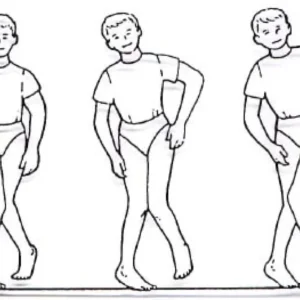Table of Contents
- 1. Introduction
- 2. Pathophysiology of Avascular Necrosis of the Hip
- 3. Risk Factors for Avascular Necrosis of the Hip
- 4. Clinical Presentation
- 5. Diagnostic Methods
- 6. Treatment Options
- 7. Prognosis and Long-Term Management
- 8. Conclusion
- References
- Other articles :
Avascular necrosis (AVN), also known as osteonecrosis, is a condition that occurs when there is a loss of blood supply to the bone, leading to the death of bone cells. It most commonly affects the hip joint, causing debilitating pain, impaired mobility, and potentially leading to joint collapse. In this article, we will explore all aspects of AVN of the hip, including its pathophysiology, risk factors, clinical presentation, diagnostic methods, treatment options, and long-term management strategies.
1. Introduction
Avascular necrosis (AVN) of the hip is a serious condition that affects the femoral head, the ball-shaped structure at the top of the femur that fits into the acetabulum of the pelvis to form the hip joint. The loss of blood supply to the femoral head leads to bone cell death, weakening the bone and eventually causing it to collapse. As the bone deteriorates, the joint loses its structural integrity, leading to pain, stiffness, and functional impairment.
The hip joint is crucial for weight-bearing activities and is subject to significant mechanical stress during movement. AVN of the hip can severely affect the quality of life, causing chronic pain and disability. The disease is often progressive and may result in osteoarthritis, requiring surgical intervention, most commonly total hip replacement (THR).
2. Pathophysiology of Avascular Necrosis of the Hip
The hip joint is highly vascularized, with blood supply provided by branches from the femoral artery, particularly the medial and lateral circumflex arteries. In AVN, there is a disruption in this blood supply, leading to ischemia (lack of blood flow) in the femoral head. Without adequate blood flow, bone cells (osteocytes, osteoblasts, and osteoclasts) are deprived of essential nutrients and oxygen, causing them to die. Over time, the bone structure weakens and collapses, leading to deformities in the hip joint.

The initial stage of AVN involves bone cell death and necrosis of trabecular bone, which is the spongy bone inside the femoral head. As the disease progresses, subchondral bone (the bone just beneath the cartilage) is affected, leading to cartilage destruction and joint degeneration. In the final stages, the femoral head can collapse completely, causing severe pain, joint deformity, and loss of function.
The collapse of the femoral head results in joint incongruity and a decrease in the congruency between the femoral head and the acetabulum, which impairs the normal function of the hip joint. This damage can lead to secondary osteoarthritis and the development of debilitating hip pain.
3. Risk Factors for Avascular Necrosis of the Hip
Several risk factors contribute to the development of AVN of the hip, some of which are modifiable, while others are non-modifiable. Understanding these risk factors is essential for both prevention and early diagnosis.
a. Trauma
One of the most common causes of AVN is traumatic injury to the hip, such as fractures of the femoral neck or dislocations of the hip joint. Trauma can damage the blood vessels supplying the femoral head, leading to ischemia and necrosis.

b. Corticosteroid Use
Long-term use of corticosteroids, particularly at high doses, is a well-established risk factor for AVN of the hip. Corticosteroids are thought to cause AVN by several mechanisms, including direct toxicity to osteoblasts, increased intraosseous pressure, and fat embolism that obstructs blood vessels. The risk increases with higher cumulative doses and prolonged use.
c. Alcohol Consumption
Excessive alcohol intake has been linked to AVN, as it can cause fatty infiltration of the bone marrow and increase intraosseous pressure, leading to compromised blood flow. Chronic alcohol abuse is one of the most significant non-traumatic risk factors for AVN.
d. Systemic Diseases
Certain systemic diseases are associated with an increased risk of AVN. These include:
- Sickle Cell Disease: The sickle-shaped red blood cells can block blood flow to the femoral head, increasing the risk of AVN.
- Systemic Lupus Erythematosus (SLE): The use of corticosteroids to manage lupus and the inflammatory nature of the disease contribute to AVN risk.
- HIV/AIDS: The virus itself, along with antiretroviral therapy, may increase the likelihood of developing AVN.
- Diabetes Mellitus: The presence of diabetes is a risk factor for AVN, possibly due to the effect of hyperglycemia on blood vessels and bone metabolism.
- Gout: Gout-related joint inflammation can lead to AVN, particularly in patients with chronic hyperuricemia.
e. Inherited Conditions
Genetic predispositions can also play a role in the development of AVN. For example, individuals with familial hyperlipidemia or those with certain genetic mutations may have an increased risk of developing AVN.
f. Other Factors
- Radiation Therapy: Individuals who have undergone radiation therapy, particularly for cancer, may develop AVN due to radiation-induced damage to the blood vessels.
- Pregnancy: In some cases, pregnancy can lead to AVN due to hormonal changes and increased pressure on the hip joints.
- Hypercoagulable States: Conditions that increase the blood’s tendency to clot, such as antiphospholipid syndrome, can lead to AVN by obstructing the blood vessels supplying the femoral head.
4. Clinical Presentation
The symptoms of AVN of the hip depend on the stage of the disease. In the early stages, patients may experience mild symptoms, while later stages are characterized by severe pain and loss of function.

a. Early Stage
In the early stages, AVN may be asymptomatic or present with vague symptoms such as mild hip pain or discomfort, which worsens with weight-bearing activities. The pain may be intermittent and is often described as aching or throbbing in nature. It may be localized to the groin, thigh, or buttock.
b. Progressive Stage
As the disease progresses and bone necrosis increases, patients may experience more persistent pain. The pain becomes more intense, particularly with activity, and may be accompanied by stiffness and limited range of motion. Patients may also experience difficulty walking and may begin to limp.
c. Advanced Stage
In the advanced stages of AVN, the femoral head may collapse, leading to severe pain and disability. The pain is often constant and can radiate down the thigh or into the knee. Joint movement becomes severely restricted, and patients may have difficulty performing daily activities such as standing, walking, or climbing stairs.
5. Diagnostic Methods
Diagnosing AVN of the hip requires a thorough clinical examination, medical history review, and imaging studies.
a. Clinical Examination
The clinician will perform a physical examination to assess the patient’s range of motion, gait, and tenderness in the hip joint. They may also test for the impingement sign and perform provocative maneuvers to assess for hip joint instability.

b. Imaging Studies
- X-ray: Initial imaging often involves plain radiographs. Early AVN may not show significant changes on X-ray, but as the disease progresses, characteristic signs such as subchondral sclerosis, cyst formation, femoral head flattening, and joint space narrowing may be seen.
- MRI: Magnetic resonance imaging (MRI) is the gold standard for diagnosing AVN. It can detect early changes in bone marrow and blood flow, even before radiographic changes occur. MRI is highly sensitive and can identify the extent of bone damage.
- CT Scan: A computed tomography (CT) scan may be used to assess the degree of bone collapse and help in surgical planning, particularly in joint-preserving procedures.
- Bone Scintigraphy: Bone scans using radiolabeled tracers can show increased uptake in areas of bone necrosis, which may be useful in detecting early-stage AVN.
6. Treatment Options
The treatment of AVN of the hip depends on the stage of the disease, the patient’s age, activity level, and overall health. The goal of treatment is to relieve pain, prevent further bone collapse, and preserve the joint as much as possible.
a. Conservative Management
- Medications: Nonsteroidal anti-inflammatory drugs (NSAIDs) and analgesics are commonly used to manage pain and inflammation in the early stages of AVN.
- Weight-bearing Restrictions: Reducing weight-bearing activities can help decrease the stress on the affected hip joint and slow the progression of the disease. Crutches or a walker may be used to offload the joint.
- Physical Therapy: Physical therapy can help improve the range of motion, strengthen the muscles around the hip, and improve joint function.
- Bisphosphonates: Medications like bisphosphonates may be used to slow the progression of bone loss and reduce pain.
b. Surgical Treatment
In advanced cases of AVN, surgical intervention is often required. Several surgical options are available, depending on the stage of the disease and the patient’s specific circumstances.
- Core Decompression: This is a procedure where a small portion of the femoral head is removed to relieve pressure and stimulate new blood vessel formation. It is most effective in early-stage AVN and may help delay the need for joint replacement.

- Osteotomy: This involves realigning the femur or acetabulum to reduce the pressure on the affected area of the femoral head. This procedure is typically performed in younger patients with early-stage AVN.
- Total Hip Replacement (THR): In cases of advanced AVN where the femoral head has collapsed and there is significant joint damage, total hip replacement (THR) is the most common surgical option. This procedure involves removing the damaged femoral head and acetabulum and replacing them with a prosthetic joint.

7. Prognosis and Long-Term Management
The prognosis of AVN depends on the stage at which the condition is diagnosed and the treatment approach. Early detection and intervention can help prevent joint collapse and preserve hip function. However, in advanced stages, total hip replacement may be necessary for pain relief and improved mobility.
**For patients undergoing joint replacement, the long-term outlook is generally favorable, with most individuals experiencing significant pain relief and improved function. However, the lifespan of the prosthetic joint can be limited, and revision surgeries may be required in the future.
8. Conclusion
Avascular necrosis of the hip is a complex and progressive condition that requires timely diagnosis and intervention. Early recognition and appropriate management can help prevent joint collapse and preserve hip function. While conservative treatments may offer relief in the early stages, advanced cases often require surgical intervention, including core decompression or total hip replacement. Understanding the underlying pathophysiology, risk factors, and treatment options is essential for improving outcomes for patients with AVN of the hip.
References
- Management of Femoral Head Osteonecrosis: Current Concepts
https://pmc.ncbi.nlm.nih.gov/articles/PMC4292325 - Conservative Treatment in Avascular Necrosis of the Femoral Head
https://pmc.ncbi.nlm.nih.gov/articles/PMC11270198 - Treatment of Non-Traumatic Avascular Necrosis of the Femoral Head
https://www.spandidos-publications.com/10.3892/etm.2022.11250 - Femoral Head Avascular Necrosis Treatment & Management
https://emedicine.medscape.com/article/86568-treatment - Avascular Necrosis of Femoral Head—Overview and Current State
https://www.mdpi.com/1660-4601/19/12/7348
Other articles :
- Global Perspectives on Folliculitis: Ayurveda’s Approach to Prevention, Treatment, and Healthcare Disparities
- How to Lose Weight in 1 Week: Ayurvedic and Research-Based Insights
- 50 Research Paper Insights into Sleep: The Ultimate Guide to Health, Cognitive Performance, and Longevity
- Top 20 Most comely Useful Instruments in Physiology lab with their classification- part 4
- BEST AYURVEDIC DIET AND NUTRITION GUIDE
- AYURVEDA INTRODUCTION
- Growth of the Ayurveda Wellness Market in 2024: Personalization, Technology, and Global Expansion
- Shat Kriyakala: Understanding 6 Stage of Disease Progression in Ayurveda and Its Modern Relevance
- Understanding Concepts 3 Doshas in Ayurveda: Tridosha
- Anatomy, Function, and Clinical Insights into the Mediastinum: A Comprehensive Overview
- Stress Relief and Mental Wellness: Understanding Causes, Effects and Effective Strategies
- Arthritis explore Ayurvedic and Modern Aspects
- Over view of the Urinary System: Embryology , Functions and Congenital Diseases





